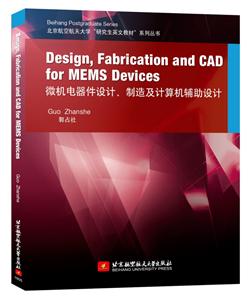-
>
闯进数学世界――探秘历史名题
-
>
中医基础理论
-
>
当代中国政府与政治(新编21世纪公共管理系列教材)
-
>
高校军事课教程
-
>
思想道德与法治(2021年版)
-
>
毛泽东思想和中国特色社会主义理论体系概论(2021年版)
-
>
中医内科学·全国中医药行业高等教育“十四五”规划教材
微机电器件设计.制造及计算机辅助设计 版权信息
- ISBN:9787512421097
- 条形码:9787512421097 ; 978-7-5124-2109-7
- 装帧:暂无
- 册数:暂无
- 重量:暂无
- 所属分类:>>
微机电器件设计.制造及计算机辅助设计 内容简介
Thisbookfirstlyintroducesthepertinentfundamentaltheory,importantmaterialandfabricationprocessofmicroGelectromechanicalsystems.Basedonthesetheories,thedesignruleandimportantengineeringexamplesaredescribedindetail.Then,manyengineeringapplicationsforMEMSincludingtheaccelerationmeasurement,theangularspeedmeasurementandthepressuremeasurementareintroduced.Finally,finiteelementmethodisintroducedinordertoprovethecorrectnessofthedesign.Thisengineeringapplicationofsimulationincludesthestaticandmodalanalysisofthebeam,capacitanceanalysis,thermalGstructureanalysisofthedeviceandfatigueanalysisetc.Itcanbeselectedasthereferencetothepostgraduates,undergraduatesandpertinentengineeringstaffwhoseresearch directionsareinstrumentationscienceandtechnology,controlscienceandengineering,mechanicalengineeringetc.
微机电器件设计.制造及计算机辅助设计 目录
1.1 ConceptofMEMS ……………………………………………………………………… 1
1.2 DevelopmentofMEMS ………………………………………………………………… 4
1.3 MEMSCAD …………………………………………………………………………… 9
Chapter2 BasictheoryofMEMS …………………………………………………………… 12
2.1 TheoryofelectrostaticMEMScombactuators …………………………………… 12
2.1.1 Introduction ……………………………………………………………………… 12
2.1.2 Operatingprinciples …………………………………………………………… 13
2.1.3 Platecapacitortheoryinidealcondition ……………………………………… 14
2.1.4 ThemodifiedmodelofMEMSplatecapaciator ……………………………… 17
2.1.5 Calculationofelectrostaticcombdrivingforceinidealsituation …………… 24
2.1.6 Weakcapacitancedetectionmethodofelectrostaticcombdrive …………… 26
2.2 RelevanttheoreticalcalculationsfortheMEMScantileverbeam ………………… 34
2.2.1 Introduction ……………………………………………………………………… 34
2.2.2 Theoreticalcalculationmethodforcantileverbeam ………………………… 35
2.2.3 RelevanttheoreticalcalculationofaxialtensileandcompressiveonsingleGend
clampedbeams ………………………………………………………………… 36
2.2.4 RelatedtheoreticalcalculationsofdoubleGendclampedbeamsaxialtension
andcompression ………………………………………………………………… 40
2.3 MembranetheoryofMEMS ………………………………………………………… 47
2.3.1 Theoryofclampedaroundcirculardiaphragm ………………………………… 48
2.3.2 Theoryofclampedaroundrectangularflatdiaphragm ……………………… 49
References …………………………………………………………………………………… 52
Chapter3 MEMSmaterials …………………………………………………………………… 53
3.1 Monocrystallinesilicon ……………………………………………………………… 53
3.1.1 Introduction ……………………………………………………………………… 53
3.1.2 Crystalorientationofmonocrystallinesilicon ………………………………… 55
3.2 Polycrystallinesilicon ………………………………………………………………… 64
3.3 Silica …………………………………………………………………………………… 66
3.4 Piezoelectricmaterials ………………………………………………………………… 67
3.4.1 Piezoelectriceffectandinversepiezoelectriceffectofmaterials …………… 67
3.4.2 Quartzcrystal …………………………………………………………………… 68
3.4.3 Piezoelectricceramics …………………………………………………………… 73
3.5 OtherMEMSmaterials ……………………………………………………………… 75
3.6 Summary ……………………………………………………………………………… 76
Chapter4 MEMStechnology ………………………………………………………………… 77
4.1 MEMSlithographyprocess ………………………………………………………… 78
4.2 KeytechnologyofMEMSlithographyprocess …………………………………… 80
4.2.1 Wafercleaning …………………………………………………………………… 80
4.2.2 Siliconoxidation ………………………………………………………………… 80
4.2.3 Spincoatingprocess …………………………………………………………… 87
4.2.4 Prebaking ………………………………………………………………………… 90
4.2.5 Exposure ………………………………………………………………………… 92
4.2.6 Development ……………………………………………………………………… 94
4.2.7 Hardening ………………………………………………………………………… 96
4.2.8 FabricationoftheSiO2 window ………………………………………………… 97
4.3 SubsequentprocessofMEMS ……………………………………………………… 98
4.3.1 Bulksilicontechnology ………………………………………………………… 98
4.3.2 Surfacesiliconprocess ………………………………………………………… 103
4.3.3 LIGAtechnology ……………………………………………………………… 104
4.3.4 Sputteringtechnology ………………………………………………………… 105
4.3.5 LiftGoffprocess ………………………………………………………………… 107
4.4 Filmpreparationtechnology………………………………………………………… 107
4.5 Bondingprocess ……………………………………………………………………… 108
4.5.1 Anodicbondingprocess………………………………………………………… 109
4.5.2 SiliconGsilicondirectbonding ………………………………………………… 110
4.5.3 Metaleutecticbonding ………………………………………………………… 113
4.5.4 Coldpressureweldingbonding ……………………………………………… 114
4.6 Engineeringexamplesofcombinationformultipleprocessestofabricatethe
MEMSdevice ………………………………………………………………………… 115
4.6.1 Introduction …………………………………………………………………… 115
4.6.2 EngineeringexampleoffabricationprocessforresonantMEMSgyroscope
…………………………………………………………………………………… 115
4.6.3 EngineeringexampleofelectromagneticmicroGmotorproductionprocess
…………………………………………………………………………………… 118
4.7 Summary ……………………………………………………………………………… 124
References…………………………………………………………………………………… 125
Chapter5 Frictionwearandtearundermicroscale ……………………………………… 126
5.1 OffGchiptestingmethodformicrofriction ………………………………………… 127
5.1.1 MicroGtribologytestwiththepinGonGdiscmeasuringmethod ……………… 127
5.1.2 MicroGtribologytestwithAFM ……………………………………………… 128
5.1.3 MicroGtribologytestwithspecialmeasuringdevice ………………………… 130
5.2 OnGchiptestingmethodformicrofriction ………………………………………… 132
5.2.1 OnGchiptestingmethodactuatedbyelectrostaticforce …………………… 132
5.2.2 OnGchipmicroGfrictiontestingmethodusingthemechanismcharactersof
thebimorphmaterial…………………………………………………………… 139
5.3 ExampleofthedesignforanonGchipmicroGfrictionstructure ………………… 141
5.3.1 Structureandworkingprinciple ……………………………………………… 141
5.3.2 Calculationofpertinenttheory ……………………………………………… 142
5.3.3 Technologicalanalysisofstructuraldesign ………………………………… 148
5.3.4 Testingresultsanddataanalysis……………………………………………… 152
5.3.5 ResearchandtestofwearproblemofMEMSdevices ……………………… 161
5.4 Summary ……………………………………………………………………………… 165
References…………………………………………………………………………………… 165
Chapter6 MEMStestingtechnologyandengineeringapplication ………………………… 169
6.1 Accelerationmeasurementandcorrespondingsensors …………………………… 169
6.1.1 Workingprincipleoftheaccelerationsensorandtheclassification ……… 170
6.1.2 Capacitivesiliconmicromechanicalaccelerometer …………………………… 172
6.1.3 Piezoresistivesiliconmicromechanicalaccelerometer ……………………… 173
6.1.4 Piezoelectricmicromechanicalaccelerometer ………………………………… 174
6.1.5 ResonantsiliconMEMSaccelerometer ……………………………………… 175
6.2 Angularspeedmeasurementandcorrespondingsensors ………………………… 177
6.2.1 Workingprinciple ……………………………………………………………… 177
6.2.2 DevelopmentofMEMSgyroscope …………………………………………… 178
6.2.3 Classificationofmicromechanicalgyroscope ………………………………… 188
6.3 Pressuremeasurementandcorrespondingsensors ……………………………… 190
6.3.1 Workingpincinple ……………………………………………………………… 190
6.3.2 Resonantsiliconmicromechanicalpressuresensoranditsdevelopment … 193
6.4 MeasurementofmicroGtorque ……………………………………………………… 198
6.4.1 Introduction …………………………………………………………………… 198
6.4.2 Workingprincipleofnoncontactmethod …………………………………… 199
6.4.3 Theoreticalcalculation ………………………………………………………… 200
6.4.4 Correspondingequipmenttorealizethenoncontactmethod ……………… 205
6.4.5 Experimentresultanddiscussion …………………………………………… 209
6.5 Microscopicmorphologytestingmethod ………………………………………… 211
6.6 Summary ……………………………………………………………………………… 212
References…………………………………………………………………………………… 212
Chapter7 Applicationexamplesofthefiniteelementmethodinthedesignof
MEMSdevices …………………………………………………………………… 218
7.1 Importantconceptsofthesoftware………………………………………………… 218
7.2 IntroductionoftheAnsyssoftwareinterface……………………………………… 220
7.3 ThecoordinatesysteminAnsys …………………………………………………… 221
7.4 Engineeringexamples ……………………………………………………………… 226
7.4.1 StaticanalysisofsingleGclampedbeam ……………………………………… 226
7.4.2 ModalanalysisofdoubleGclampedbeam ……………………………………… 245
7.4.3 CapacitanceanalysisofMEMSelectrostaticcombfingersdrive …………… 257
7.4.4 Fatiguestrengthcalculationexample ………………………………………… 264
7.5 Summary ……………………………………………………………………………… 272
- >
苦雨斋序跋文-周作人自编集
苦雨斋序跋文-周作人自编集
¥6.1¥16.0 - >
中国历史的瞬间
中国历史的瞬间
¥16.7¥38.0 - >
自卑与超越
自卑与超越
¥13.7¥39.8 - >
有舍有得是人生
有舍有得是人生
¥25.7¥45.0 - >
企鹅口袋书系列·伟大的思想20:论自然选择(英汉双语)
企鹅口袋书系列·伟大的思想20:论自然选择(英汉双语)
¥6.3¥14.0 - >
唐代进士录
唐代进士录
¥16.1¥39.8 - >
我与地坛
我与地坛
¥16.4¥28.0 - >
龙榆生:词曲概论/大家小书
龙榆生:词曲概论/大家小书
¥8.7¥24.0
-
UG NX 10.0模具设计教程
¥38.2¥59 -
计算机组成原理(微课版)
¥45¥69.8 -
电路基础/于宝琦
¥31.9¥49 -
通信电源
¥23.9¥38.8 -
计算机操作系统-(第四版)
¥19¥53 -
科学技术概论
¥30.4¥49
屯留后河——战国至西汉墓葬考古发掘报告
¥291.0¥388.0复杂地质隧道围岩稳定与结构设计理论
¥117.7¥149.0环境监测技术
¥21.4¥24.0麦麦蹲绘本
¥23.1¥36.8世界儿童钢琴名典集
¥34.3¥68.0

















